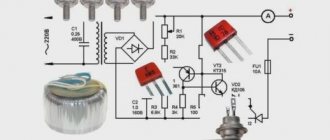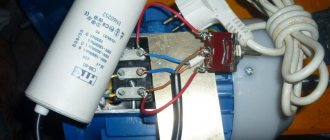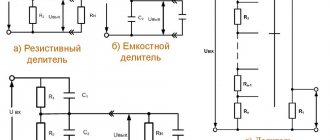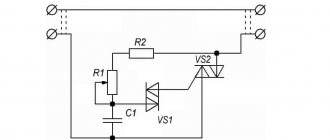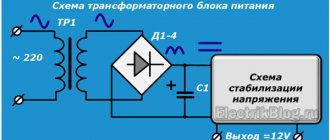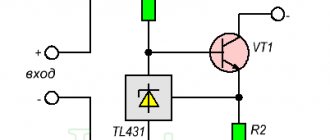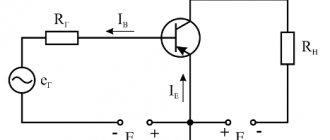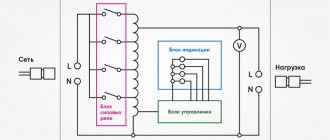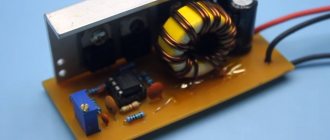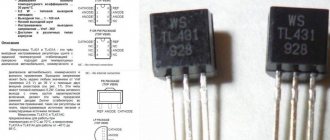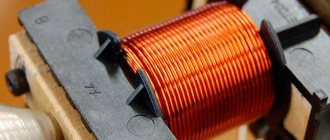To convert voltage of one level to voltage of another level, pulse voltage converters using inductive energy storage devices are often used. Such converters are characterized by high efficiency, sometimes reaching 95%, and have the ability to produce increased, decreased or inverted output voltage.
In accordance with this, three types of converter circuits are known: buck (Fig. 1), boost (Fig. 2) and inverting (Fig. 3).
Five elements are common to all these types of converters :
- power supply,
- key switching element,
- inductive energy storage (inductor, inductor),
- blocking diode,
- a filter capacitor connected in parallel with the load resistance.
The inclusion of these five elements in various combinations allows you to implement any of the three types of pulse converters.
The converter output voltage level is regulated by changing the width of the pulses that control the operation of the key switching element and, accordingly, the energy stored in the inductive energy storage device.
Stabilization of the output voltage is realized by using feedback: when the output voltage changes, the pulse width automatically changes.
Buck switching converter
The step-down converter (Fig. 1) contains a series-connected chain of switching element S1, inductive energy storage L1, load resistance RH and filter capacitor C1 connected in parallel with it. Blocking diode VD1 is connected between the connection point of the key S1 with the energy storage device L1 and the common wire.
Rice. 1. Operating principle of a step-down voltage converter.
When the switch is open, the diode is closed, energy from the power source is accumulated in an inductive energy storage device. After the switch S1 is closed (open), the energy stored by the inductive storage L1 is transferred through the diode VD1 to the load resistance RH. Capacitor C1 smoothes out voltage ripples.
Efficiency of a pulse voltage converter
The output of such circuits will always be either constant or pulsating voltage. You cannot get alternating voltage at their output.
General circuit of a boost pulse converter with a storage choke:
The signal that must be sent to point A1 in relation to the common wire:
General circuit of a step-down pulse converter with a storage choke:
The signal that must be supplied to point B1 in relation to the source of the transistor:
How do pulse converters with storage choke work?
Let's look at the example of a boost converter. The storage inductor L1 is connected in such a way that when transistor T1 opens, current from the “+PIT” source begins to flow through them, while the current does not increase in the inductor instantly, since the energy is stored in the magnetic field of the inductor. After transistor T1 closes, the energy stored in the inductor must be released, this follows from the physics of the phenomena occurring in the inductor, respectively, the only path of this energy runs through the +PIT source, diode VD1 and the load connected to the OUTPUT. In this case, the maximum output voltage depends on only one thing - the load resistance. If we have an ideal inductor and if there is no load, then the voltage at the output will be infinitely large, but we are dealing with a far from ideal inductor, so without a load the voltage will simply be very large, perhaps so large that a breakdown of air or dielectric between the OUTPUT terminal will occur and a common wire, but rather a breakdown of the transistor.
Boost switching converter
The step-up pulse voltage converter (Fig. 2) is made on the same basic elements, but has a different combination: a series chain of inductive energy storage L1, diode VD1 and load resistance RH with a filter capacitor C1 connected in parallel is connected to the power source. The switching element S1 is connected between the connection point of the energy storage device L1 with the diode VD1 and the common bus.
Rice. 2. Operating principle of a boost voltage converter.
When the switch is open, current from the power source flows through the inductor, which stores energy. Diode VD1 is closed, the load circuit is disconnected from the power source, key and energy storage device.
The voltage across the load resistance is maintained thanks to the energy stored on the filter capacitor. When the switch is opened, the self-induction EMF is summed with the supply voltage, the stored energy is transferred to the load through the open diode VD1. The output voltage obtained in this way exceeds the supply voltage.
Operating principle of a pulse converter
Several types of converter designs have been developed, which differ in their operating principles:
- step-down (buck converter) – devices capable of reducing the input voltage to a given one;
- step-up (boost converter) – used when it is necessary to increase the output voltage relative to the input;
- buck-boost converter – capable of operating both to lower and to increase voltage;
- SEPIC (single-ended primary-inductor converter) - has similar parameters, but works on a different principle;
- inverting converter – main purpose – inversion of voltage polarity.
Almost all designs use the property of inductance to store energy. The circuit with the inductor (choke) is controlled by a key, the role of which is performed by a high-speed transistor. The differences in the circuits lie in the relative position of the inductor, storage tank and key element.
Step-down
The circuit contains an inductance located after the key element and connected in series with the load. When the key is open, current begins to flow through the inductor. The diode is closed at this time. After closing the key, the current does not stop instantly, but continues to circulate in the same direction, but through the open diode.
We advise you to study Frequency Converter
Step-down converter
Subsequently, the work cycle is repeated. The output capacitance allows you to smooth out output voltage ripples.
Step-up
This boost voltage converter also contains a choke connected in series with the load, but it is located before the switch. When the switch is open, a current flows through the inductance, which increases linearly. After closing the key, the current continues to flow through the open diode to the load. In this case, the input voltage is added to the self-induction emf of the inductor.
Step-up converter
The remaining circuits have similar circuitry.
In all cases, the diode blocks the load from the switch at the required point in the conversion cycle. The voltage drop across the diode causes additional power to be dissipated, which reduces the efficiency of the device. Therefore, instead of ordinary diodes with a drop of about 0.7V, high-speed Schottky diodes are used, the voltage drop of which is 0.4V.
Pulse type inverting converter
A pulse-type inverting converter contains the same combination of basic elements, but again in a different connection (Fig. 3): a series chain of switching element S1, diode VD1 and load resistance RH with filter capacitor C1 is connected to the power source.
Inductive energy storage L1 is connected between the connection point of the switching element S1 with the diode VD1 and the common bus.
Rice. 3. Pulse voltage conversion with inversion.
The converter works like this: when the key is closed, energy is stored in an inductive storage device. Diode VD1 is closed and does not pass current from the power source to the load. When the switch is turned off, the self-inductive emf of the energy storage device is applied to a rectifier containing diode VD1, load resistance Rн and filter capacitor C1.
Since the rectifier diode passes only negative voltage pulses into the load, a voltage of a negative sign is formed at the output of the device (inverse, opposite in sign to the supply voltage).
How and where to use the device correctly
The use of pulse devices requires compliance with certain conditions:
- shielding of the device body to reduce the level of radiated interference;
- installation of filters at the input of the device to prevent the transmission of interference through the power supply network;
- ensuring air circulation for effective cooling of the power elements of the circuit.
The maximum permissible load can only be connected to the power source at a high input voltage. This is due to the fact that when it is reduced to ensure nominal output values, the semiconductor switches of the inverter generator are in the open state most of the time. This can cause them to overheat and fail.
You might be interested in Installing a radio doorbell
Important! Most pulse voltage converter circuits are designed in such a way that some of the elements are at network potential, which can cause an electric shock. Such converters can only be used if the structure is reliably grounded.
Pulse converters and stabilizers
To stabilize the output voltage of pulse stabilizers of any type, conventional “linear” stabilizers can be used, but they have low efficiency. In this regard, it is much more logical to use pulse voltage stabilizers to stabilize the output voltage of pulse converters, especially since such stabilization is not at all difficult.
Switching voltage stabilizers, in turn, are divided into stabilizers with pulse-width modulation and stabilizers with pulse-frequency modulation. In the first of them, the duration of control pulses changes while their repetition rate remains unchanged. Secondly, on the contrary, the frequency of control pulses changes while their duration remains unchanged. There are also pulse stabilizers with mixed regulation.
Below we will consider amateur radio examples of the evolutionary development of pulse converters and voltage stabilizers.
Pulse-width converter
During operation, a device is used that accumulates energy as a result of transformation. It can be included in the basic structure or connected directly to the input voltage without reference to the converter. One way or another, the output will have an average voltage, determined by the value of the input voltage and the duty cycle of the pulses from the switching switch. The operational amplifier contains a special computer that evaluates the parameters of the input and output signals, recording the difference between them. If the output voltage is less than the reference voltage, then a modulator is connected to the regulation, increasing the duration of the open state of the switching key relative to the operating time of the clock generator. As the input voltage changes, the switching converter adjusts the switch control circuitry so that the difference between the output and reference voltages is minimized.
Units and circuits of pulse converters
The master oscillator (Fig. 4) of pulse converters with an unstabilized output voltage (Fig. 5, 6) on the KR1006VI1 microcircuit operates at a frequency of 65 kHz. The output rectangular pulses of the generator are fed through RC circuits to transistor key elements connected in parallel.
Inductor L1 is made on a ferrite ring with an outer diameter of 10 mm and a magnetic permeability of 2000. Its inductance is 0.6 mH. The efficiency of the converter reaches 82%.
Rice. 4. Master oscillator circuit for pulse voltage converters.
Rice. 5. Diagram of the power part of a step-up pulse voltage converter +5/12 V.
Rice. 6. Circuit of an inverting pulse voltage converter +5/-12 V.
The output ripple amplitude does not exceed 42 mV and depends on the capacitance value of the capacitors at the device output. The maximum load current of the devices (Fig. 5, 6) is 140 mA .
The converter rectifier (Fig. 5, 6) uses a parallel connection of low-current high-frequency diodes connected in series with equalizing resistors R1 - R3.
This entire assembly can be replaced by one modern diode, designed for a current of more than 200 mA at a frequency of up to 100 kHz and a reverse voltage of at least 30 V (for example, KD204, KD226).
As VT1 and VT2, it is possible to use transistors of the KT81x type with a p-p-p structure - KT815, KT817 (Fig. 4.5) and p-p-p - KT814, KT816 (Fig. 6) and others.
To increase the reliability of the converter, it is recommended to connect a diode of type KD204, KD226 in parallel with the emitter-collector junction of the transistor so that it is closed to direct current.
Pulse converter chips
Stabilizer integrated circuits have been developed for many standard applications. The use of microcircuits allows you to create designs that contain a minimum number of elements and do not require customization. In the case of powering a small load, even the use of powerful key elements is not required. This allows you to create small-sized and reliable power supplies. As an example, chargers for mobile phones.
Converter on IC
Integrated circuits in converters can perform various functions, so they are divided according to their functional purpose:
- pulse width converters;
- Schmidt triggers;
- Surge Protectors.
A wide range of ICs are produced that combine all of the above functions. The same microcircuit can be produced by different manufacturers under its own name.
Note! The design and construction of pulse voltage converters is facilitated by the presence of a large number of standard circuits that have been tested in operation and are simple and reliable.
As for repairing the device, in many cases it is not practical to do this, since the time and labor intensity of the work are not comparable to the low cost of the elements and the finished structure.
Thus, the inverter is an important device both in everyday life and in industry. Thanks to it, the coordinated operation of electrical equipment and networks is ensured. But when using it, it is important to take into account the conditions and rules.
Converter with master oscillator-multivibrator
To obtain an output voltage of 30...80 V, P. Belyatsky used a converter with a master oscillator based on an asymmetrical multivibrator with an output stage loaded on an inductive energy storage device - inductor (choke) L1 (Fig. 7).
Rice. 7. Circuit of a voltage converter with a master oscillator based on an asymmetrical multivibrator.
The device is operational in the supply voltage range of 1.0. ..1.5 V and has an efficiency of up to 75%. In the circuit, you can use a standard inductor DM-0.4-125 or another with an inductance of 120...200 μH.
An embodiment of the output stage of the voltage converter is shown in Fig. 8. When a 7777-level (5 V) rectangular control signal cascade is applied to the input of the cascade, the output of the converter, when powered from a 12 V produces a voltage of 250 V at a load current 3...5 mA (load resistance is about 100 kOhm). Inductance of inductor L1 is 1 mH.
As VT1, you can use a domestic transistor, for example, KT604, KT605, KT704B, KT940A(B), KT969A, etc.
Rice. 8. Option for the output stage of the voltage converter.
Rice. 9. Diagram of the output stage of the voltage converter.
A similar circuit of the output stage (Fig. 9) made it possible, when powered from a source with a voltage of 28V and a current consumption of 60 mA to obtain an output voltage of 250 V at a load current of 5 mA . The inductance of the inductor is 600 μH. The frequency of control pulses is 1 kHz.
Depending on the quality of the inductor, the output voltage can be 150...450 V with a power of about 1 W and an efficiency of up to 75%.
Parameters of pulse converters
Now that we have tested the behavior of the circuit in practice, it is worth knowing the most important parameters of these extremely useful modules. A switching converter, like any power system, can be described by several basic properties, the most important of which are discussed below.
Output voltage - can be constant (unregulated) or set within a certain range. If it is constant, the manufacturer must indicate with what error it is determined, for example, 5 V (± 0.2 V). In our experiment, we used a converter with a constant output voltage.
| Be careful not to exceed the permissible parameters under any circumstances. If the voltage is too high, the inverter may be damaged! |
The maximum output current is the current that can be continuously supplied from the converter output. This will depend on the input voltage.
Input voltage - depending on the type of converter, should be:
- below the output if the circuit is a boost type (other name: boost),
- higher than the output, if the circuit is step-down (other name: buck),
- higher or lower but within the range if the circuit is boost/buck (also known as SEPIC).
In the case of the first two configurations, the manufacturer must also specify the minimum voltage that must be installed between the input and output of the converter. In the case of linear stabilizers, we are talking about a minimum voltage drop. The third configuration has a specified range in which the input voltage should fall - the circuit itself will decide whether to increase or decrease it.
| A boost/buck converter is great if we want to get 5V and the battery supplies between 4 and 6V (depending on charge). The converter will cope with this without problems - first it will reduce the voltage and then begin to increase it. |
Efficiency should be understood as the ratio of output power to input power . The difference between these powers is the losses that will be released in the form of heat. Expressed as a percentage. The closer to 100%, the better for us.
The efficiency depends on the so-called operating conditions, i.e. the applied voltage and the consumed current. Therefore, you should carefully study the manufacturer’s datasheets for diagrams. It may turn out that a very expensive converter has worse parameters than a much cheaper one.
In the case of linear regulators, the efficiency depends on the difference between the input and output voltage . The greater this difference, the more power we lose in the circuit. For the stabilizer discussed earlier, the efficiency was only 42%.
Voltage converter based on KR1006VI1
A voltage converter based on a pulse generator based on a DA1 KR1006VI1 microcircuit, an amplifier based on a field-effect transistor VT1 and an inductive energy storage device with a rectifier and filter is shown in Fig. 10.
At the output of the converter, with a supply voltage of 9V and a current consumption of 80...90 mA, of 400...425 V is generated . It should be noted that the value of the output voltage is not guaranteed - it significantly depends on the design of the inductor (choke) L1.
Rice. 10. Circuit of a voltage converter with a pulse generator on the KR1006VI1 microcircuit.
To obtain the desired voltage, the easiest way is to experimentally select an inductor to achieve the required voltage or use a voltage multiplier.
Pulse voltage converters
To convert electricity, or more precisely, voltage, you can use various devices, such as transformers, generators, chargers. All of them are electrical energy converters. Since many modern devices require not only alternating but also direct voltage to power them, it is not always possible to use an energy source such as a rechargeable battery for these purposes. It is she who produces the ideal constant voltage through a chemical reaction. Previously, only low-frequency transformers, paired with a rectifier and a smoothing filter, were used to convert and reduce voltage. However, they were very large in size. With the growth and development of innovative technologies in everyday life and in production, electronic devices began to appear that require miniature converting devices. This is how pulsed DC voltage converters appeared. Their miniature size is required more for portable mobile devices than for stationary ones.
All pulse converters can be divided into the following groups:
- Boost, buck, invert;
- With and without stabilization;
- With and without galvanic isolation;
- Regulated and unregulated;
- Having different ranges of input and output voltage.
However, pulse converters are assembled using more complex circuits than their predecessors, classic step-down rectifiers.
Bipolar pulse converter circuit
To power many electronic devices, a bipolar voltage source is required, providing both positive and negative supply voltages. The diagram shown in Fig. 11 contains much fewer components than similar devices due to the fact that it simultaneously functions as a boost and inverter inductive converter.
Rice. 11. Converter circuit with one inductive element.
The converter circuit (Fig. 11) uses a new combination of main components and includes a four-phase pulse generator, an inductor and two transistor switches.
Control pulses are generated by a D-trigger (DD1.1). During the first phase of the pulses, inductor L1 stores energy through transistor switches VT1 and VT2. During the second phase, switch VT2 opens and energy is transferred to the positive output voltage bus.
During the third phase, both switches are closed, as a result of which the inductor again accumulates energy. When the VT1 key is opened during the final phase of the pulses, this energy is transferred to the negative power bus. , the circuit provides output voltages of ±12 V. The timing diagram (Fig. 11, right) shows the formation of control pulses.
Transistors KT315, KT361 can be used in the circuit.
Pulse width modulation
The output parameters are adjusted by controlling the duration of the open and closed states of the key element. The most common principle is pulse width modulation.
The transistor is switched by high-frequency pulses of constant frequency. Opening and closing times are determined by the width of the pulses. The tracking circuit monitors the output voltage by comparing it with a reference. The mismatch signal is sent to the modulator, which regulates the parameters of the control pulses.
Pulse width modulation
In modern designs, all these functions are assigned to a specialized integrated circuit, making the circuit design of switching power supplies with pulse width modulation (PWM) simple and reliable.
Voltage converter with stable 30V
The voltage converter (Fig. 12) allows you to obtain a stabilized voltage of 30 V at the output. A voltage of this magnitude is used to power varicaps, as well as vacuum fluorescent indicators.
Rice. 12. Circuit of a voltage converter with a stabilized output voltage of 30 V.
On a DA1 chip of type KR1006VI1, a master oscillator is assembled according to the usual circuit, producing rectangular pulses with a frequency of about 40 kHz.
A transistor switch VT1 is connected to the output of the generator, which switches the inductor L1. The amplitude of the pulses when switching the coil depends on the quality of its manufacture.
In any case, the voltage on it reaches tens of volts. The output voltage is rectified by diode VD1. A U-shaped RC filter and a zener diode VD2 are connected to the output of the rectifier. The voltage at the output of the stabilizer is entirely determined by the type of zener diode used. As a “high-voltage” zener diode, you can use a chain of zener diodes having a lower stabilization voltage.
Voltage converter with inductive energy storage
A voltage converter with an inductive energy storage, which allows maintaining a stable regulated voltage at the output, is shown in Fig. 13.
Rice. 13. Voltage converter circuit with stabilization.
The circuit contains a pulse generator, a two-stage power amplifier, an inductive energy storage device, a rectifier, a filter, and an output voltage stabilization circuit. Resistor R6 sets the required output voltage in the range from 30 to 200 V.
Transistor analogues: VS237V - KT342A, KT3102; VS307V - KT3107I, BF459 - KT940A.
Buck and invert voltage converters
Two options - step-down and inverting voltage converters [4.1] are shown in Fig. 14. The first of them provides an output voltage of 8.4 V at a load current of up to 300 mA , the second allows you to obtain a voltage of negative polarity ( -19.4 V ) at the same load current. The output transistor VTZ must be installed on the radiator.
Rice. 14. Circuits of stabilized voltage converters.
Transistor analogues: 2N2222 - KTZ117A 2N4903 - KT814.
Step-down stabilized voltage converter
A step-down stabilized voltage converter that uses the KR1006VI1 (DA1) microcircuit as a master oscillator and has load flow protection is shown in Fig. 15. The output voltage is 10V when the load current is up to 100mA.
Rice. 15. Step-down voltage converter circuit.
When the load resistance changes by 1%, the output voltage of the converter changes by no more than 0.5%. Transistor analogues: 2N1613 - KT630G, 2N2905 - KT3107E, KT814.
Bipolar voltage inverter
To power electronic circuits containing operational amplifiers, bipolar power supplies are often required. This problem can be solved by using a voltage inverter, the circuit of which is shown in Fig. 16.
The device contains a square pulse generator loaded onto inductor L1. The voltage from the inductor is rectified by diode VD2 and supplied to the output of the device (filter capacitors C3 and C4 and load resistance). Zener diode VD1 ensures a constant output voltage - it regulates the duration of the pulse of positive polarity on the inductor.
Rice. 16. Voltage inverter circuit +15/-15 V.
The operating frequency of generation is about 200 kHz under load and up to 500 kHz without load. Maximum load current is up to 50 mA, device efficiency is 80%. The disadvantage of the design is the relatively high level of electromagnetic interference, which, however, is also typical for other similar circuits. A DM-0.2-200 throttle was used as L1.
Characteristics
Pulse voltage converters
The main characteristics important to the consumer are:
- Input voltage range;
- Output voltage level;
- Maximum load current;
- No-load current;
- Converter efficiency;
- Output ripple level;
- Level of electromagnetic interference;
- Galvanic isolation of input and output.
These parameters largely depend on the design features of the structure.
Inverters on specialized chips
It is most convenient to assemble highly efficient modern voltage converters using microcircuits specially created for these purposes.
KR1156EU5 microcircuit (MC33063A, MC34063A from Motorola) is designed to operate in stabilized step-up, step-down, and inverting converters with a power of several watts.
In Fig. Figure 17 shows a diagram of a step-up voltage converter based on the KR1156EU5 microcircuit. The converter contains input and output filter capacitors C1, C3, C4, storage choke L1, rectifier diode VD1, capacitor C2, which sets the operating frequency of the converter, filter choke L2 for smoothing ripples. Resistor R1 serves as a current sensor. The voltage divider R2, R3 determines the output voltage.
Rice. 17. Circuit of a step-up voltage converter on the KR1156EU5 microcircuit.
The operating frequency of the converter is close to 15 kHz at an input voltage of 12 V and rated load. The voltage ripple range on capacitors C3 and C4 was 70 and 15 mV, respectively.
Inductor L1 with an inductance of 170 μH is wound on three glued rings K12x8x3 M4000NM with PESHO 0.5 wire. The winding consists of 59 turns. Each ring should be broken into two parts before winding.
A common spacer made of PCB with a thickness of 0.5 mm is inserted into one of the gaps and the package is glued together. You can also use ferrite rings with a magnetic permeability of over 1000.
An example of a step-down converter on the KR1156EU5 microcircuit is shown in Fig. 18. A voltage of more than 40 V cannot be supplied to the input of such a converter. The operating frequency of the converter is 30 kHz at UBX = 15 V. The voltage ripple range on capacitors C3 and C4 is 50 mV.
Rice. 18. Scheme of a step-down voltage converter on the KR1156EU5 microcircuit.
Rice. 19. Scheme of an inverting voltage converter based on the KR1156EU5 microcircuit.
Choke L1 with an inductance of 220 μH is wound in a similar way (see above) on three rings, but the gluing gap was set to 0.25 mm, the winding contained 55 turns of the same wire.
The following figure (Fig. 19) shows a typical circuit of an inverting voltage converter based on the KR1156EU5 microcircuit. The DA1 microcircuit is powered by the sum of the input and output voltages, which should not exceed 40 V.
Converter operating frequency - 30 kHz at UBX=5 S; the range of voltage ripples on capacitors C3 and C4 is 100 and 40 mV.
For inductor L1 of the inverting converter with an inductance of 88 μH, two K12x8x3 M4000NM rings with a gap of 0.25 mm were used. The winding consists of 35 turns of PEV-2 0.7 wire. Inductor L2 in all converters is standard - DM-2.4 with an inductance of 3 μGh. Diode VD1 in all circuits (Fig. 17 - 19) must be a Schottky diode.
To obtain bipolar voltage from unipolar voltage, MAXIM has developed specialized microcircuits. In Fig. Figure 20 shows the possibility of converting a low level voltage (4.5...5 6) into a bipolar output voltage 12 (or 15 6) with a load current of up to 130 (or 100 mA).
Rice. 20. Voltage converter circuit based on the MAX743 chip.
In terms of its internal structure, the microcircuit does not differ from the typical design of similar converters made on discrete elements, however, the integrated design makes it possible to create highly efficient voltage converters with a minimum number of external elements.
Thus, for the MAX743 (Fig. 20), the conversion frequency can reach 200 kHz (which is much higher than the conversion frequency of the vast majority of converters made on discrete elements). With a supply voltage of 5 V, the efficiency is 80...82% with output voltage instability of no more than 3%.
The microcircuit is equipped with protection against emergency situations: when the supply voltage drops 10% below normal, as well as when the case overheats (above 195°C).
To reduce ripple at the output of the converter with a conversion frequency (200 kHz), U-shaped LC filters are installed at the device outputs. Jumper J1 on pins 11 and 13 of the microcircuit is designed to change the value of the output voltages.
To convert low level voltage (2.0...4.5 6) into stabilized 3.3 or 5.0 V, a special microcircuit developed by MAXIM is used - MAX765 . Domestic analogues are KR1446PN1A and KR1446PN1B. A microcircuit for a similar purpose - MAX757 - allows you to obtain a continuously adjustable output voltage within the range of 2.7...5.5 V.
Rice. 21. Circuit of a low-voltage step-up voltage converter to a level of 3.3 or 5.0 V.
The converter circuit shown in Fig. 21, contains a small number of external (hinged) parts.
This device works according to the traditional principle described earlier. The operating frequency of the generator depends on the input voltage and load current and varies over a wide range - from tens of Hz to 100 kHz.
The magnitude of the output voltage is determined by where pin 2 of the DA1 microcircuit is connected: if it is connected to a common bus (see Fig. 21), the output voltage of the KR1446PN1A is 5.0 ± 0.25 V, but if this pin is connected to pin 6, then the output voltage will drop to 3.3±0.15 V. For the KR1446PN1B , the values will be 5.2±0.45 V and 3.44±0.29 V, respectively.
The maximum output current of the converter is 100 mA . MAX765 chip provides an output current of 200 mA of 5-6 and 300 mA at a voltage of 3.3 V. Converter efficiency is up to 80%.
The purpose of pin 1 (SHDN) is to temporarily disable the converter by connecting this pin to common. The output voltage in this case will drop to a value slightly less than the input voltage.
The HL1 LED is designed to indicate an emergency reduction in the supply voltage (below 2 V), although the converter itself is capable of operating at lower input voltage values (up to 1.25 6 and below).
The L1 inductor is made on a K10x6x4.5 ring made of M2000NM1 ferrite. It contains 28 turns of 0.5 mm PESHO wire and has an inductance of 22 µH. Before winding, the ferrite ring is broken in half, after being filed with a diamond file. Then the ring is glued with epoxy glue, installing a 0.5 mm thick textolite gasket in one of the resulting gaps.
The inductance of the inductor obtained in this way depends to a greater extent on the thickness of the gap and to a lesser extent on the magnetic permeability of the core and the number of turns of the coil. If you accept the increase in the level of electromagnetic interference, then you can use a DM-2.4 type inductor with an inductance of 20 μGh.
Capacitors C2 and C5 are type K53 (K53-18), C1 and C4 are ceramic (to reduce the level of high-frequency interference), VD1 is a Schottky diode (1 N5818, 1 N5819, SR106, SR160, etc.).
Power supply for powering portable and pocket receivers
The transformerless power supply (Fig. 23) is designed to power portable and pocket receivers from an AC mains voltage of 220 V. It should be taken into account that this source is not electrically isolated from the supply network. With an output voltage of 9V and a load current of 50 mA, the power supply consumes about 8 mA from the network.
Rice. 23. Scheme of a transformerless power source based on a pulse voltage converter.
The mains voltage, rectified by the diode bridge VD1 - VD4 (Fig. 23), charges capacitors C1 and C2. The charging time of capacitor C2 is determined by the circuit constant R1, C2. At the first moment after turning on the device, thyristor VS1 is closed, but at a certain voltage on capacitor C2 it will open and connect circuit L1, C3 to this capacitor.
In this case, capacitor C3 of large capacity will be charged from capacitor C2. The voltage on capacitor C2 will decrease, and on C3 it will increase.
The current through inductor L1, equal to zero at the first moment after opening the thyristor, gradually increases until the voltages on capacitors C2 and C3 are equalized. As soon as this happens, the thyristor VS1 will close, but the energy stored in the inductor L1 will for some time maintain the charging current of the capacitor C3 through the opened diode VD5. Next, diode VD5 closes, and a relatively slow discharge of capacitor C3 through the load begins. Zener diode VD6 limits the voltage across the load.
As soon as the thyristor VS1 closes, the voltage on capacitor C2 begins to increase again. At some point, the thyristor opens again, and a new cycle of operation of the device begins. The opening frequency of the thyristor is several times higher than the voltage pulsation frequency on capacitor C1 and depends on the ratings of the circuit elements R1, C2 and the parameters of the thyristor VS1.
Capacitors C1 and C2 are MBM type for a voltage of at least 250 V. Inductor L1 has an inductance of 1...2 mH and a resistance of no more than 0.5 Ohm. It is wound on a cylindrical frame with a diameter of 7 mm.
The winding width is 10 mm, it consists of five layers of PEV-2 0.25 mm wire, wound tightly, turn to turn. An SS2.8x12 tuning core made of M200NN-3 ferrite is inserted into the frame hole. The inductance of the inductor can be varied within wide limits, and sometimes even eliminated completely.
Schemes of devices for energy conversion
Diagrams of devices for energy conversion are shown in Fig. 24 and 25. They are step-down energy converters powered by rectifiers with a quenching capacitor. The voltage at the output of the devices is stabilized.
Rice. 24. Scheme of a step-down voltage converter with transformerless mains power supply.
Rice. 25. Option of a step-down voltage converter circuit with transformerless mains power supply.
As VD4 dinistors, you can use domestic low-voltage analogues - KN102A, B. Like the previous device (Fig. 23), power supplies (Fig. 24 and 25) have a galvanic connection with the supply network.
Voltage converter with pulse energy storage
In the S. F. Sikolenko voltage converter with “pulse energy storage” (Fig. 26), switches K1 and K2 are made on KT630 transistors, the control system (CS) is on a K564 series microcircuit.
Rice. 26. Circuit of a voltage converter with pulse accumulation.
Storage capacitor C1 - 47 µF. A 9 V battery is used as a power source. The output voltage at a load resistance of 1 kOhm reaches 50 V. The efficiency is 80% and increases to 95% when using CMOS structures such as RFLIN20L as key elements K1 and K2.
Types of DC-DC converters
There are different types of DC-DC converters:
- Without inductors, assembled using capacitors. There are options with fixed and adjustable voltage. Such inverters are suitable for powering low power loads. To assemble an adjustable DC-DC converter circuit, you do not need to have winding components. This allows you to assemble modules of compact sizes with minimal costs.
- With inductor, without galvanic isolation. Contains 1 isolated power supply. The conversion method (up, down, polarity reversal) depends on the key position. Field-effect transistors (FETs) and insulated gate bipolar transistors (IGBTs) are commonly used as key components.
Devices with inductance are:
- Increasing type. The operating principle and microcircuits of DC-DC boost converters will be discussed further.
- Step-down - with a switch transistor. A pulse width modulator is used to control it.
- With the ability to regulate the value of Uout - suitable for obtaining an increased or decreased value of the output voltage. They are used in devices in which the voltage is set by a Li-ion battery, and its voltage gradually decreases. Such an inverter easily maintains the specified output value.
- With an arbitrary value of Uout, i.e. with the possibility of increasing and decreasing it. Such DC-DC voltage converters are used in circuits in which the voltage is set by a Li-ion type energy storage device. Their rated voltage decreases during battery operation, and it becomes necessary to change it to an output value of 3.3 V.
- With galvanic isolation. They contain pulse transformers with a number of windings. There is no connection between the input and output circuits. There is a significant potential difference between the voltage values at the ends. In particular, such converters are used in power supplies for pulsed photo flashes with Uout about 400 V.
Pulse-resonant converter
Pulse-resonant converters designed by the so-called. N. M. Muzychenko, one of which is shown in Fig. 4.27, depending on the shape of the current in the VT1 switch, they are divided into three types, in which the switching elements close at zero current and open at zero voltage. At the switching stage, the converters operate as resonant converters, and the rest, most of the period, as pulse converters.
Rice. 27. Scheme of a pulse-resonance converter N. M. Muzychenko.
A distinctive feature of such converters is that their power part is made in the form of an inductive-capacitive bridge with a switch in one diagonal and with a switch and power supply in the other. Such schemes (Fig. 27) are highly efficient.
Source: Shustov M. A. Practical circuitry. Voltage converters.
Technical characteristics of the device
The technical characteristics of inverters for the most part coincide with those of classical power supplies. But there are also differences. The pulse converter can operate with a wider input voltage range, has smaller weight and dimensions, and higher efficiency. The devices are characterized by a high level of high-frequency interference, but this can be easily reduced by using filters. Due to the high frequency, the dimensions of the filter are small.
Note! The inverter has a negative input resistance. In practice, this is expressed in the fact that as the supply voltage increases, the current consumption decreases.
You may be interested in Installing an electric meter on the street
